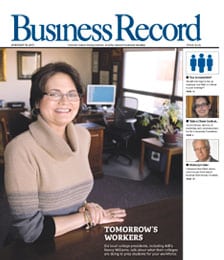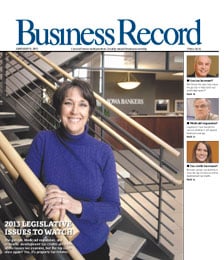Lukewarm commercial leases getting hotter

Officials with Grubb & Ellis Co./Knight Frank say leasing activity in the Des Moines commercial real estate office market slowly improved during the first quarter of 2003, while vacancy rates for in neighboring metro areas, including St. Louis, Minneapolis and Omaha, remained flat or continued to increase. Those were among the findings reported in the company’s first-quarter analysis of market trends released last week.
In January, company officials predicted the second half of 2003 would be stronger than the first half due to increased absorption of excess space that was put on the market in late 2001 and 2002. Although activity levels remain fairly similar to last year, three Grubb & Ellis real estate agents confirmed that the office market has steadily improved in the last month. They noted that several large tenants are exploring the possibility of moving into buildings in excess of 20,000 square feet. But unlike the first quarter of 2002, few large blocks of space are available for most companies, Grubb & Ellis officials said.
“I think the market is stable,” said Julie Brown, an associate of the Grubb & Ellis/Mid-America Pacific office advisory services group. “I’m thrilled by the amount of activity we’ve seen in the last 30 days. There’s been a little spike.”
Bill Wright, vice president and retail team leader at Grubb & Ellis, who has worked with tenants in downtown Des Moines’ booming East Village, said activity has picked up in the central business district. In the East Village alone, seven new office deals were completed in the area between the Des Moines River and state capitol.
“This is the most activity we’ve seen in the East Village in many years,” Wright said.
According to the survey, the suburban market also had increased leasing activity during the first quarter, led by National Travelers Life Co. and LaMair-Mulock-Condon Co. absorbing sublease space in the western suburbs. Companies like IKON, which moved into a 11,495-square-foot space in Building I at Clive’s Deer Wood Office Park, and Ameriquest Mortgage, which leased 17,589 square feet of space at Building 4 in Regency West Office Park, spurred leasing activities.
Meanwhile, at the nearly completed University Center structure at 128th Street and University Avenue in Clive, RBC Dain Rauscher will occupy nearly 12,000 square feet of office space in the center’s upper level.
Dean Weitenhagen, a Grubb & Ellis associate who works with office and investment deals, said like most industries, the commercial real estate market follows the economy. He attributes Des Moines’ steady economy to the success of financial services businesses, which are weathering the storm of a slumping economy.
“It’s a sign of our conservative nature,” he said. “We’re hearing that financial companies are doing well and there are a lot of white-collar jobs in Des Moines in that industry.”
Not only are financial services a calming influence on the market in terms of helping to stabilize the economy, they are some of the tenants responsible for Des Moines’ low vacancy rates. In the first quarter, the survey found Des Moines’ central business district vacancy rate to be 11.6 percent and its suburban rate to be10.9 percent.
That’s a contrast to Minneapolis, where the survey found that landlords are struggling to fill large volumes of empty space with a suburban vacancy rate of 18 percent; to Omaha, where new construction and recent sublease offerings have pushed suburban vacancies to a 10-year high of 16.9 percent with a downtown rate of 25.2 percent; and to St. Louis, where the market was flat, with a vacancy rate in its central business district at 14.1 percent.
Though local real estate agents are cautiously optimistic, Wright said there is room for improvement in Des Moines’ commercial real estate market. The movement of tenants to occupy 2,000 to 10,000 square-foot buildings is slower than it was in the late 1990s and early 2000. Landlords continue to focus on tenant retention, and small pockets of space will become available as tenants downsize upon the expiration of their leases.
“I’d like to see pockets of second-generation Class B buildings get filled in downtown,” Wright said. “That would help landlords out and help lease rates.”







